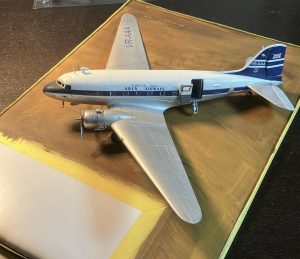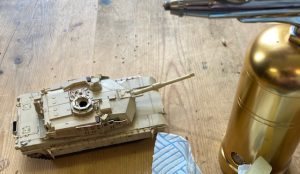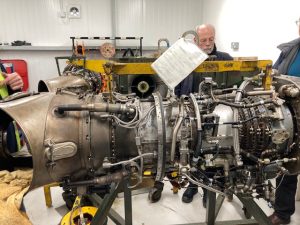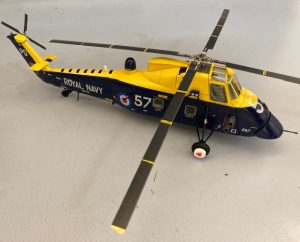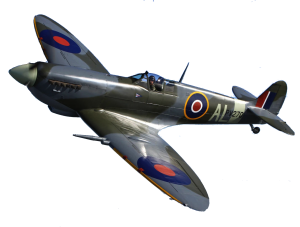 The Supermarine Spitfire is a British single-seat fighter aircraft that was used by the Royal Air Force and other Allied countries before, during, and after World War II. Many variants of the Spitfire were built, using several wing configurations, and it was produced in greater numbers than any other British aircraft. It was also the only British fighter produced continuously throughout the war. The Spitfire continues to be popular among enthusiasts; nearly 60 remain airworthy, and many more are static exhibits in aviation museums throughout the world.
The Supermarine Spitfire is a British single-seat fighter aircraft that was used by the Royal Air Force and other Allied countries before, during, and after World War II. Many variants of the Spitfire were built, using several wing configurations, and it was produced in greater numbers than any other British aircraft. It was also the only British fighter produced continuously throughout the war. The Spitfire continues to be popular among enthusiasts; nearly 60 remain airworthy, and many more are static exhibits in aviation museums throughout the world.
The Spitfire was designed as a short-range, high-performance interceptor aircraft by R. J. Mitchell, chief designer at Supermarine Aviation Works, which operated as a subsidiary of Vickers-Armstrong from 1928. Mitchell pushed the Spitfire’s distinctive elliptical wing with cutting-edge sunken rivets (designed by Beverley Shenstone) to have the thinnest possible cross-section, helping give the aircraft a higher top speed than several contemporary fighters, including the Hawker Hurricane. Mitchell continued to refine the design until his death in 1937, whereupon his colleague Joseph Smith took over as chief designer, overseeing the Spitfire’s development through its multitude of variants.
During the Battle of Britain, from July to October 1940, the public perceived the Spitfire to be the main RAF fighter, though the more numerous Hurricane shouldered a greater proportion of the burden against Nazi Germany’s air force, the Luftwaffe. However, Spitfire units had a lower attrition rate and a higher victory-to-loss ratio than those flying Hurricanes because of the Spitfire’s higher performance. During the battle, Spitfires were generally tasked with engaging Luftwaffe fighters—mainly Messerschmitt Bf 109E-series aircraft, which were a close match for them.
After the Battle of Britain, the Spitfire superseded the Hurricane to become the backbone of RAF Fighter Command, and saw action in the European, Mediterranean, Pacific, and South-East Asian theatres. Much loved by its pilots, the Spitfire served in several roles, including interceptor, photo-reconnaissance, fighter-bomber, and trainer, and it continued to serve in these roles until the 1950s. The Seafire was a carrier-based adaptation of the Spitfire that served in the Fleet Air Arm from 1942 through to the mid-1950s. Although the original airframe was designed to be powered by a Rolls-Royce Merlin engine producing 1,030 hp (768 kW), it was strong enough and adaptable enough to use increasingly powerful Merlins and, in later marks, Rolls-Royce Griffon engines producing up to 2,340 hp (1,745 kW). As a result, the Spitfire’s performance and capabilities improved over the course of its service life.
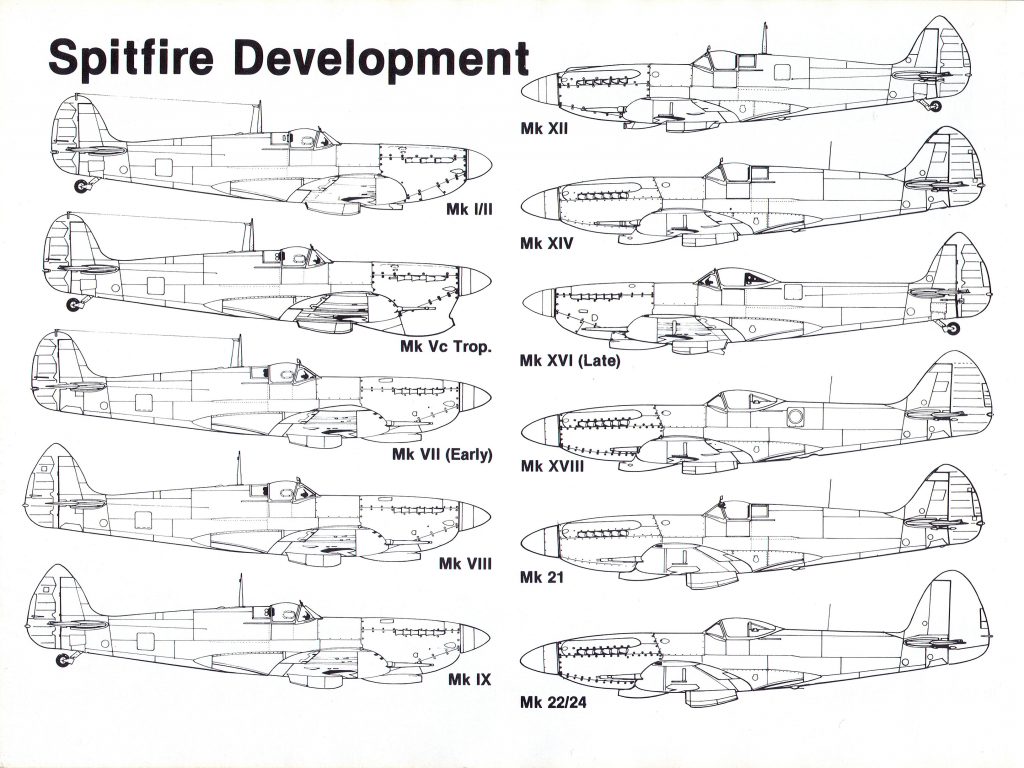
Spitfire I
Original production model with 1,030-hp Merlin II engine, 8 Browning 0.303-in guns (Mk IB had 2 20-mm cannons and 4 0.303-in machine guns), Total aircraft 1,566.
Spitfire II
Castle Bromwich aircraft with small changes and 1,175-hp Merlin XII engine, Total aircraft 750 IIA and 170 IIB.
Spitfire III
Experimental prototype with 1,280-hp Merlin XX engine, Total aircraft 1.
Spitfire IV
Griffon engined prototype
Spitfire V
Strengthened fuselage for 1,440-hp Merlin 45 or 1,470-hp Merlin 50, drop tank and bomb provisions, A (8 machine guns), B (2 cannon & 4 machine guns), or C (4 cannons) armament, Total aircraft 94 VA, 3,923 VB, and 2,447 VC.
Spitfire VI
High altitude interceptor with 1,415-hp Merlin 47, pressurized cockpit and pointed wings, Total aircraft 100.
Spitfire VII
High altitude interceptor with 2 stage Merlin 61, 64 or 71, pressurized cockpit, retractable tailwheel, often broad pointed rudder, Total aircraft 140.
Spitfire VIII
Definitive fighter with 2 stage Merlin 61, 63, 66, or 70, unpressurized, Total aircraft 1,658.
Spitfire IX
Temporary stop-gap, marriage of 2 stage Merlin 61, 63, 66, or 70 with Mk V airframe, B, C, or E (2 cannons & 2 0.5-in machine guns) armament, Total aircraft 5,665.
Spitfire X
Pressurized version of PR.XI, Merlin 77, Total aircraft 16.
Spitfire XI
Unarmed reconnaissance aircraft, Merlin 61, 63, or 70, Total aircraft 471.
Spitfire XII
Low level interceptor, single stage Griffon II or IV of 1,735-hp, B armament, Total aircraft 100.
Spitfire XIII
Low level PR aircraft based on Mk V but with Merlin 32 (3 blade prop), Four 0.303-in machine guns only, Total aircraft 18.
Spitfire XIV
2 stage Griffon 65 or 66 of 2.050-hp driving 5 blade propeller and redesigned & strengthened airframe with symmetric deep radiators, broad tail, and often teardrop canopy, C or E armament, Total aircraft 957.
Spitfire XVI
Mk IX with Packard Merlin 266, usually C or E armament, many with teardrop canopy, Total aircraft 1,054.
Spitfire XVIII
Definitive fighter with 2 stage Griffon, E armament, teardrop canopy, extra wing fuel, FR.XVIII (post-war FR.18) with rear fuselage reconnaissance camera, Total aircraft 300.
Spitfire XIX
Unarmed PR version, 2 stage Griffon, most pressurized, Total aircraft 225.
Spitfire XX
Prototype rebuilt from Mk.IV and prototype Mk.XII, Total aircraft 225.
Spitfire 21
Redesigned airframe, mainly Griffon 61 or 64 driving five bladed propeller, Four 20-mm guns, Total aircraft 122.
Spitfire 22
Minor changes, some with 2,375-hp Griffon 85, and contra-prop Total aircraft 278.
Spitfire 24
Minor changes, Spiteful tail, short barrel Mk V cannon, Total aircraft 54.
